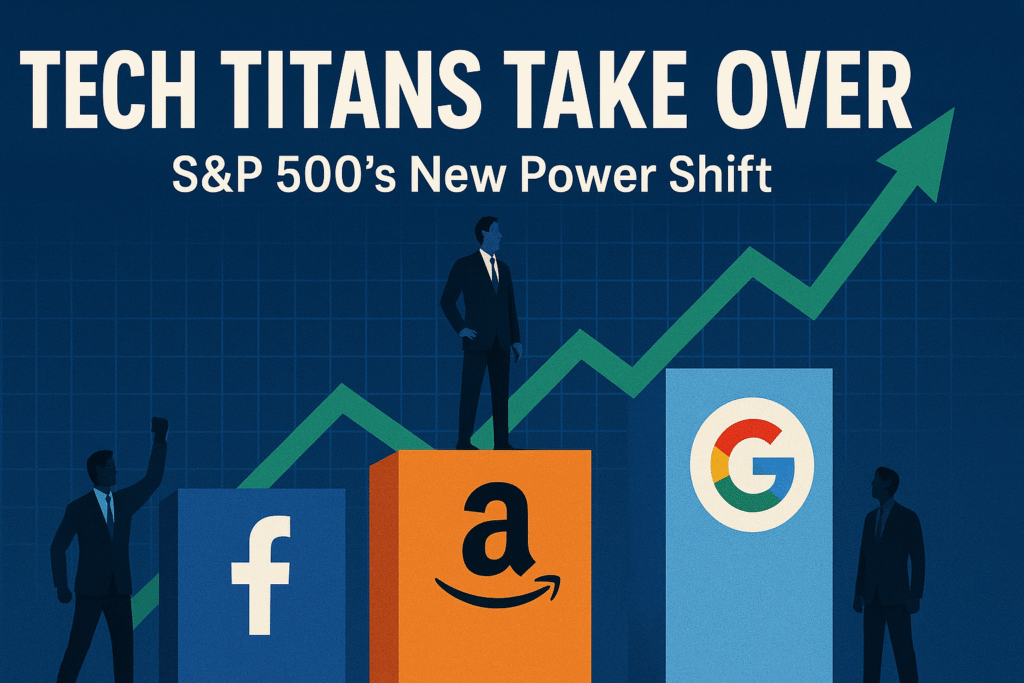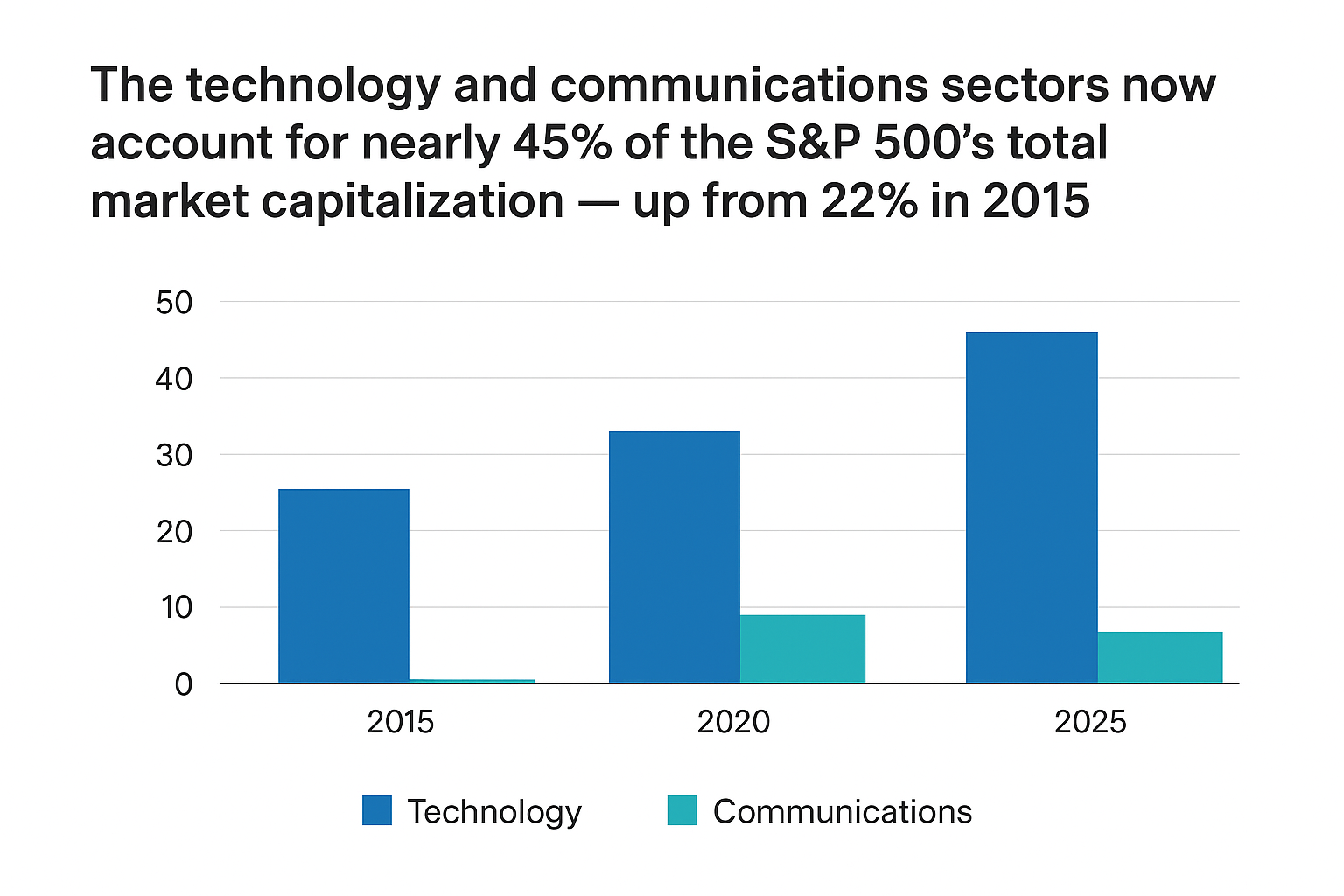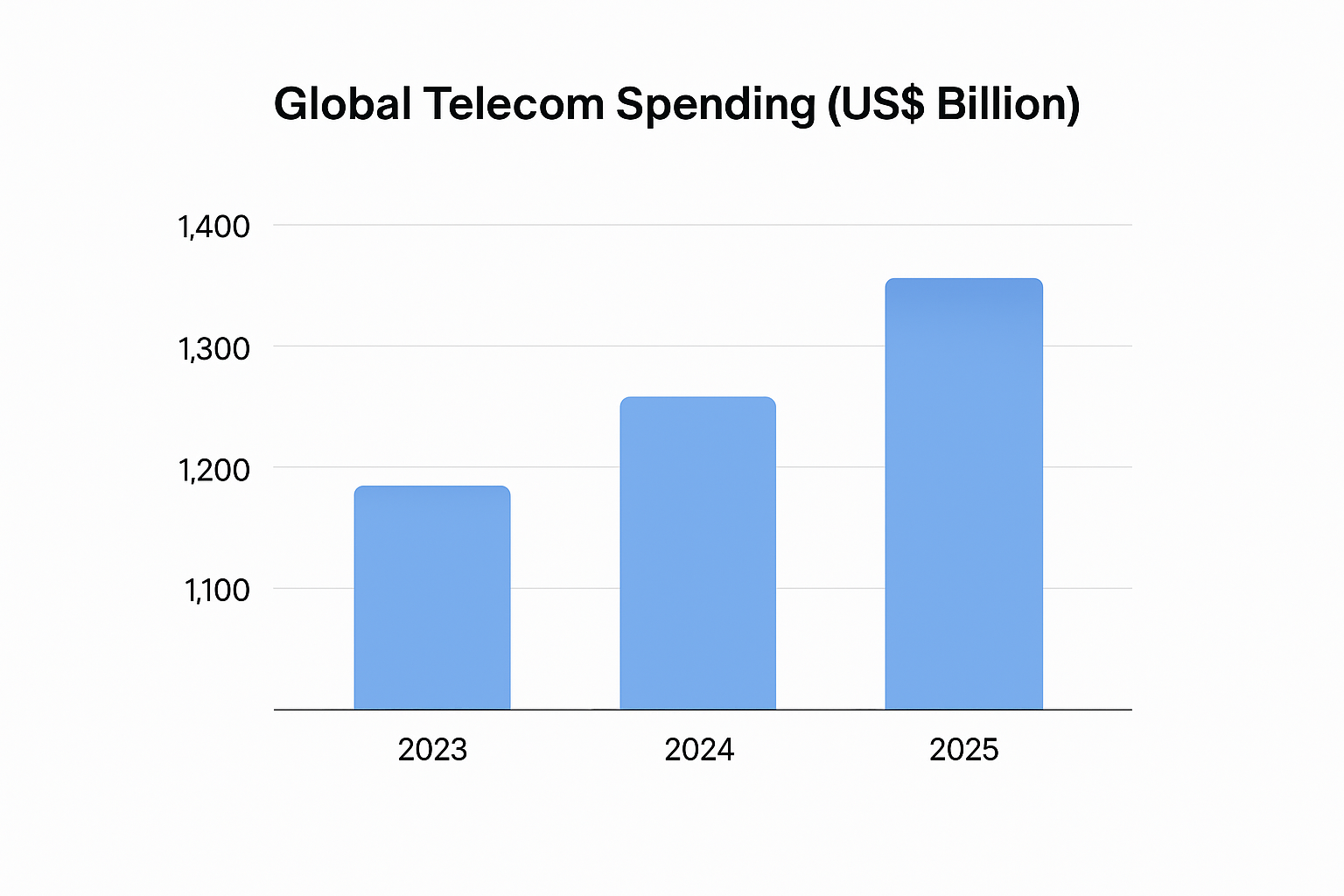Introduction
Tech Titans Take Over– In recent years, the global equity landscape has undergone a seismic shift. The convergence of artificial intelligence, cloud computing and digital platforms has propelled the technology and communications sectors into dominant positions. Today, these industries represent not just a powerful growth engine — they have emerged as the ballast of the market. Yet at the same time, the more traditional telecom players are quietly offering an income-oriented alternative for investors seeking stability in a world of rapid disruption.
As of October 20, 2025, technology and communications firms account for roughly 45% of the S&P 500 market‐capitalization. That’s up from around 22% in 2015. (While published data vary slightly, multiple reports confirm that tech’s weight in the S&P has soared to more than one-third or more than 30%. (RBC Wealth Management – Asia))
Key companies such as Nvidia Corporation, Apple Inc., Microsoft Corporation and Alphabet Inc. alone now contribute well over 20% of the Index’s total weighting. (For example, Nvidia’s ~7.3% alone in mid-2025.) (Reuters)
This degree of concentration echoes past market cycles — notably the railroad boom of the 1840s — and raises both opportunity and risk for the corporate finance and investor community.
At the same time, telecom stocks are gaining attention for what they deliver: income, stability and less dramatic price volatility. For example, AT&T, offering a yield of ~4.2%-4.3%, is approaching its earnings release on October 22, 2025, giving dividend-biased investors a potential entry point. (AT&T Newsroom)

In this article we’ll explore:
- The rise of tech and communications within the S&P 500 and what it means for market concentration and volatility.
- Why this dominance might counterintuitively reinforce the case for diversification.
- The current telecom landscape, including global telecom spending projections and sector momentum.
- A deep dive into AT&T: recent performance, strategic moves, earnings outlook and dividend appeal.
- What CFOs, investors and corporate finance professionals should watch going into Q3-2025 earnings.
- A conclusion and actionable summary for the income-seeking investor.
Section 1: Tech & Communications — From 22 % to 45 % of the S&P

A structural shift
Over the past decade the composition of the S&P 500 has been gradually but unmistakably transformed. Where once the energy, materials and industrial sectors held large weights, the digital era has placed technology and communications at the core. In fact, several sources indicate that the tech sector alone now comprises more than 30 % of the S&P 500’s market cap. (U.S. Bank)
One recent note from Apollo’s “Extreme AI Concentration” paper finds that as of August 2025, tech firms accounted for an outsized share of index market-cap relative to their net-income contribution. (Apollo Academy)
What’s driving this? Several forces:
- AI and machine-learning infrastructure are propelling demand for semiconductors, cloud services and enterprise software.
- Digital platforms continue to capture advertising, commerce and consumer engagement.
- Cloud computing allows companies to scale globally at ever-lower marginal cost.
- Networks and connectivity underlie virtually every modern business, shifting “communications” into a growth engine rather than a utility.
Market concentration and the “Magnificent 7” effect
The weight of the largest five or so stocks in the index has grown dramatically. For example: Nvidia ~7.3 %, Apple ~7 %, Microsoft ~6 % as of 2025. (Reuters)
This has two primary implications:
- Volatility risk: When an index’s performance is disproportionately driven by a handful of names, any reversal or disappointment among those names can drag the broader market.
- Diversification challenge: Investors who believe they are diversified may in fact be heavily exposed to the same underlying thematic risk — namely digital/AI growth — even if their allocation spans sectors.
Historical analogy — the 1840s railroad boom
In the 1840s the railroad industry represented a technological and infrastructural revolution. Land speculation, rail construction and connectivity redefined economies. But ultimately, the concentration in rail-linked firms led to overleverage, speculative excess and significant downturns when reality belied expectation.
The figurative parallel is compelling: today’s AI-cloud-platform boom may be delivering value, but the degree to which the market is aligned behind a handful of themes and names means the same sort of structural risk is present.
Why this dominance matters for corporate finance professionals
For CFOs and finance-teams at non-tech firms, this market transformation has practical implications:
- Cost of capital: Firms outside the tech/communications complex may face higher cost of equity simply because investor preference is tilted toward growth/digital.
- Capital allocation: Firms must ask whether they are allocating toward “digital backbone” initiatives (cloud, data, connectivity) or risk being viewed as legacy.
- Investor relations messaging: Emphasising subscription-models, recurring revenue, digital transformation and network effect may resonate more than purely asset-heavy narratives.
Summary of the challenge
The dominance of tech and communications in the S&P 500 implies that the market is far less “balanced” than in previous decades. That raises questions about market resilience, the value of diversification, and the place of income-oriented sectors in a world tilted toward growth.
Section 2: Telecom Sector Momentum — A Case for Income & Stability
While much of investor attention is on high-growth names, the telecom sector has quietly been rebuilding momentum — and for good reason.
Sector performance and spending outlook
In the current quarter, traditional telecom companies have shown strong signals of investor interest, with average gains of approximately 14.3% since the previous reporting cycle. This uptick reflects increased attention to income-oriented stocks as earnings season approaches.
At the same time, global telecom spending is forecast to rise ~4% in 2025 to roughly US $1.42 trillion, according to Statista, supporting the notion of steady demand for connectivity and network upgrades.

Why telecom is more than just “utility”
Several structural tailwinds have emerged:
- 5G rollout and mid-band spectrum deployments.
- Fiber broadband build-outs, including residential and enterprise connections.
- Digital convergence: telecom firms becoming hybrid connectivity-plus-services rather than just carriage pipes.
- A demographic and structural shift: more people working from home, streaming, gaming, and requiring more bandwidth.
Income appeal
For investors focused on dividend yield and income stability, telecom continues to deliver. The sector typically trades at lower forward P/E multiples than high-growth tech, reflecting slower growth but also less risk of value destruction if the growth narrative falters.
Current context
Given the dominance of growth stocks (and the attendant valuation risk), the relative balance that telecom offers (moderate growth + income) is increasingly attractive. From a corporate-finance vantage point, telecom firms that are managing declines in legacy business lines while shifting into fibre/5G are becoming more interesting for income-focused holdings.
Section 3: Deep Dive — AT&T Inc. (T)
Now we turn our focus to one of the most-watched large-cap telecom players: AT&T Inc. (NYSE: T). For the income investor and the finance professional alike, AT&T offers a compelling illustration of how legacy telecom firms are transitioning.
Company profile & business overview
AT&T has its roots in the Bell System divestiture of 1982 and subsequent consolidation during the 1990s. Its business model runs on recurring-revenue from wireless and broadband customers, backed by substantial nationwide network infrastructure.
In recent years AT&T has streamlined its operations, focusing more aggressively on wireless and fiber broadband while moving away from legacy assets (for example, the sale/exit of its remaining 70 % stake in DIRECTV). (Investing.com)
Recent performance at a glance
- In Q2 2025, AT&T generated revenue of US $30.8 billion, with adjusted EPS of US $0.54 — exceeding analysts’ expectations of ~US $0.52. (Public)
- Analysts are expecting the Q3 2025 results (to be reported Oct 22, 2025) to show revenue near ~US $30.88 billion and EPS around US $0.54. (GuruFocus)
- For the full year 2025, AT&T is guiding adjusted EPS in the range of US $1.97 to US $2.07. (Investors.com)
- According to Simply Wall St, AT&T’s expected earnings growth is ~7.5% p.a., revenue growth ~1.9% p.a., with return on equity estimated at ~14%. (Simply Wall St)
Valuation and dividend profile
- Forward P/E: Approximately 12.8×, which is notably below the sector average of ~13.98× (as quoted in your content).
- Dividend yield: ~4.2%-4.3%—significantly higher than the telecom-sector average around ~2.6%.
- Recent quarterly dividend: US $0.278 per share.
- The payout ratio: forward payout ratio is about 50-51%, which signals that the dividend is well supported by earnings at this point.
Strategic moves and business transformation
AT&T has not been standing still. Some strategic initiatives worth highlighting:
- Fiber and broadband growth: The company added ~446,000 fiber + Internet Air connections in the latest period, and fiber-broadband revenue is up ~19% year-on-year to ~US $2.1 billion.
- 5G and network innovation: AT&T, in partnership with Boldyn Networks, has rolled out service inside New York City’s Joralemon Street subway tunnel (serving the 4 and 5 lines) — marking an early step in what the company describes as one of Brooklyn’s biggest wireless upgrades in years.
- Embedded mobile-plan partnerships: Via a collaboration with Gigs, technology brands can embed AT&T mobile plans directly within their apps – a new distribution modality that can reach new users with minimal marketing cost. Klarna is the first partner.
- Community and digital-inclusion programmes: AT&T has committed US $725,000 (via Digitunity) across Arkansas, Mississippi and Louisiana to give ~13,200 people access to computers, internet service and digital-skills training. This supports public-policy and reputational goals.
- Enterprise communications expansion: Through its Office@Hand offering and partnerships with RingCX and RingSense (AI-driven tools for customer-call management and service-team coaching) AT&T is enhancing its enterprise services layer, moving up the value ladder.
Why now might be a “window” for dividend investors
Several elements suggest that AT&T currently represents an interesting entry point for income-oriented investors:
- Earnings momentum: With Q2 results beating expectations and Q3 due imminently (Oct 22), the company has exhibited consistent execution.
- Yield advantage: At ~4.2–4.3%, the yield is materially higher than many large-cap telecom peers and significantly above broader market dividend yields.
- Valuation cushion: A forward P/E in the low-teens offers a reasonable valuation buffer relative to the growth names in tech.
- Business transition visibility: The shift toward fiber/5G, new partnerships and enterprise services provides a narrative of growth – albeit moderate – that complements the income story.
- Diversification benefit: In a market where tech dominates, a telecom hold like AT&T offers exposure to stable recurring cash flows rather than high-beta growth.
Risks and caveats
Of course, no investment is without risk, and AT&T is no exception. Some key points for CFOs and investors to keep in mind:
- The legacy wireline and legacy business-line segments continue to drag; margin compression in those areas may limit upside.
- While the yield is attractive, the expected growth (~2% revenue growth) is modest compared to tech peers, which means upside is limited absent major execution.
- Debt levels remain substantial and capital expenditures (fiber/5G) are high; managing leverage and free-cash-flow is crucial.
- Delivery on subscriber growth (wireless + broadband) is important — any slowdown could raise concerns.
- Market sentiment for telecoms tends to lag, so upside may be slower and more methodical than in high-growth tech stocks.
Analyst sentiment
Analysts heading into Q3 2025 have been largely supportive. For example:
- Bernstein’s Laurent Yoon reiterated a “Buy” with a ~$32 price target, citing undervaluation of AT&T’s ability to convert execution into stronger earnings and cash flow.
- Citi’s Michael Rollins also maintained a “Buy” rating, focusing on consistent subscriber additions and fiber traction.
- Wells Fargo’s Eric Luebchow continued in “Buy” territory with a ~$29 target, highlighting disciplined capital allocation and margin improvement.
Based on current price levels (~US $26 as of writing) and mean analyst targets (~US $30.65), there is an implied upside of ~18% alongside a 4% + yield.
Corporate finance lens
For corporate finance executives and investors, the AT&T story offers several teachable take-aways:
- The importance of recurring-revenue models (wireless subscriptions + broadband) in delivering cash-flow stability.
- Capital-allocation discipline: how fiber, 5G and enterprise services investments are funded amid still-large legacy expenditures.
- The strategic pivot from legacy media (e.g., sale of DirecTV stake) toward core connectivity and growth services.
- Communication with investors: articulating how dividend, buyback, free-cash-flow and growth fit together.
- Risk-management: balancing income appeal with exposure to growth narrative and structural change in telecom.
Section 4: What CFOs and Investors Should Watch as Q3 2025 Approaches
With AT&T’s earnings due on October 22, 2025, and in the wider context of a tech-heavy market, what key metrics and dynamics should finance professionals keep an eye on?
- Subscriber growth trends: Especially postpaid wireless net adds and broadband/fiber net adds. These are leading indicators of growth momentum.
- Revenue growth in key segments: Mobility and fiber broadband growth – where AT&T is guiding mid-to-high teens in fiber growth and ~3%+ mobility growth.
- Margin/EBITDA trends: Legacy wireline segments may still compress margins; how well fiber and mobile offset that is critical.
- Free cash flow & capital expenditures: Given heavy investment in network infrastructure, how much free cash flow remains for dividends/buybacks is key.
- Guidance for full-year 2026/2027 and beyond: Any commentary on capital discipline, leverage reduction, or acceleration of growth helps.
- Dividend sustainability: While currently well-covered, any meaningful shift in payout ratio would draw investor attention.
- Macro factors: With tech stocks holding large weight, any signs of broad market re-rating could impact telecoms. Also, regulatory, spectrum and infrastructure policy remain relevant.
- Valuation relative to alternatives: As we begin to see potential for tech valuations to come under scrutiny, telecoms could benefit, but the narrative needs to support that shift.
Section 5: Broader Lessons for Portfolio & Capital-Allocation Strategy
Diversification in a tech-concentrated index
Given that nearly half of the S&P 500’s market-cap now sits within tech and communications (and that a handful of stocks dominate the index), the case for diversification is stronger than ever. While growth stocks may continue to drive the market, their dominance also increases systemic risk. From a CFO perspective, non-tech companies should evaluate how much their cost of capital, investor base and strategic narrative are being influenced by this concentration.
Income-oriented holdings benefit from rotation potential
If investor sentiment begins to rotate away from growth and toward income/defensive sectors (for example, as valuation questions arise around AI and platform stocks), telecoms like AT&T could benefit. The narrative of “yield plus moderate growth” becomes more appealing when growth expectations in tech are tempering.
Capital-allocation trade-offs
Companies across sectors may ask themselves:
- Should we invest heavily in growth/innovation (cloud, AI, platform) or reinforce stable recurring-revenue models (connectivity, subscription)?
- How do we communicate our valuation story and dividend/buyback policy effectively given market preferences?
- Are we exposed to the thematic risk of being “outside the winner take all digital ecosystem”?
The cautionary tale of concentration
Just as the 1840s railroad boom ended with speculative excess and structural adjustment, the current dominance of tech raises caution flags. For corporate finance leaders, the lesson is: even as growth is embraced, structural diversification and balance sheet discipline remain essential.
Conclusion
As of October 20, 2025, the technology and communications sectors’ weight in the S&P 500 underscores the era we live in: one defined by connectivity, data, digital platforms and recurring-revenue models. In this terrain, companies such as Nvidia, Apple, Microsoft and Alphabet dominate the conversation. Yet this dominance comes with heightened valuation and concentration risk — a reminder that growth alone does not guarantee resilience.
Simultaneously, the telecom sector offers a compelling counter-narrative: less spectacular growth, but stronger income, recurring cash flows and structural tailwinds (5G, fiber, connectivity). Within this space, AT&T stands out. With its ~4.2%-4.3% dividend yield, modest valuation, visible transition to fiber & 5G and income-oriented story, it may well represent a logical holding for long-term, income-seeking investors and CFOs alike.
For finance leaders, the key take-aways are:
- Reassess your capital-allocation strategy in an environment where digital growth is rewarded but also scrutinised.
- Ensure your business narrative emphasises recurring revenue, growth visibility and network effect — if you aim to appeal to the growth-biased investor base.
- Consider the value of balancing growth with stability: telecom and connectivity playbooks may gain favour if market sentiment shifts.
- Maintain focus on cash-flow generation, dividend sustainability and balance-sheet discipline in a world where thematic market actors dominate.
In short: when the market is crowded with tech-platform narratives, the value of diversification — both for portfolios and corporate strategies — becomes clearer. Whether you’re a CFO planning capital investment, or an investor chasing yield and stability, the interplay between growth, income and valuation matters more than ever.
For CFO STimes, this story resonates because it speaks directly to the corporate finance community: how market composition is evolving, how capital-allocation imperatives are shifting and how the traditional telecom player is adapting into a digital-connectivity engine. As the next earnings cycle unfolds (including AT&T’s Oct 22 release), it is worth watching closely whether the income-oriented telecom sector can gain further ground in the shadow of the tech behemoths.
Disclosure: This article is for informational purposes only. It does not constitute investment advice. Please consult your financial advisor or corporate finance specialist before making any investment or capital-allocation decisions.
